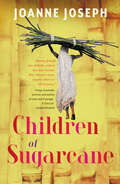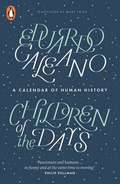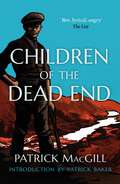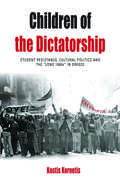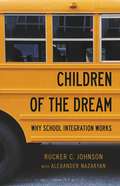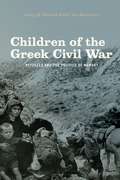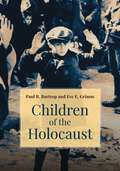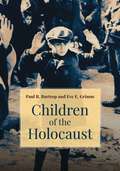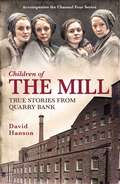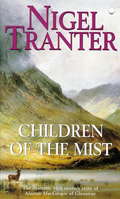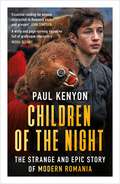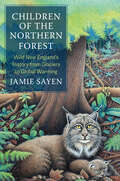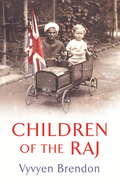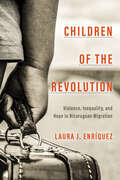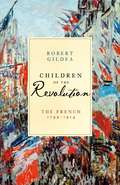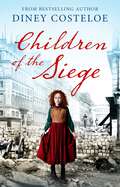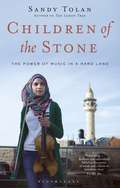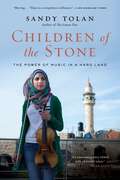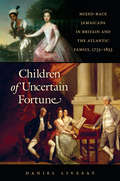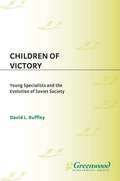- Table View
- List View
Children of Sugarcane
by Joanne Joseph"Shanti is a heroine that the reader will not easily forget. The story that is told here is worth not only knowing but also remembering." – Siphiwe Gloria Ndlovu, author, filmmaker and academicVividly set against the backdrop of 19th century India and the British-owned sugarcane plantations of Natal, written with great tenderness and lyricism, Children of Sugarcane paints an intimate and wrenching picture of indenture told from a woman’s perspective.Shanti, a bright teenager stifled by life in rural India and facing an arranged marriage, dreams that South Africa is an opportunity to start afresh. The Colony of Natal is where Shanti believes she can escape the poverty, caste, and troubling fate of young girls in her village. Months later, after a harrowing sea voyage, she arrives in Natal only to discover the profound hardship and slave labour that await her.Spanning four decades and two continents, Children of Sugarcane demonstrates the lifegiving power of love, heartache, and the indestructible bonds between family and friends. These bonds prompt heroism and sacrifice, the final act of which leads to Shanti's redemption.
Children of the Days: A Calendar of Human History
by Eduardo GaleanoFrom Eduardo Galeano, one of Latin America's greatest living writers, author of the Memory of Fire trilogy, comes Children of the Days a new kind of history that shows us how to remember and how to liveThis book is shaped like a calendar. Each day brings with it a story: a journey, feast or tragedy that really happened on that date, from all possible years and all corners of the world. From Abdul Kassem Ismail, the tenth-century Persian who never went anywhere without his library - all seventeen thousand books of it, on four hundred camels; to the Brazilian city of Sorocaba, which on February 8 1980 responded to the outlawing of public kissing by becoming one huge kissodrome; to July 1 2008, the day the US government decided to remove Nelson Mandela's name from its list of dangerous terrorists, Children of the Days takes aim at the pretensions of official history and illuminates moments and heroes that we have all but forgotten. Through this shimmering historical mosaic runs a common thread, one that joins humanity's darkest hours to its sweetest victories. Children of the Days is the story of our lives.'Galeano performs the sort of extraordinary feats of compassion, artistry, and imagination achieved in fiction by his fellow visionary Latin American writers, especially Borges, García Márquez, and Bolaño' Booklist, starred review'Galeano's prose is nearly lulling in its lyricism' Neil Gordon, New York Times Book Review'The elegance of Galeano's words - they're just penetrating, so beautiful' San Francisco Chronicle, Danny GloverEduardo Galeano is one of Latin America's most distinguished writers. He is the author of the three-volume Memory of Fire; Open Veins of Latin America; Soccer in Sun and Shadow; The Book of Embraces; Walking Words; Upside Down; and Voices in Time. Born in Montevideo in 1940, he lived in exile in Argentina and Spain for years before returning to Uruguay. His work has been translated into twenty-eight languages. He is recipient of many international prizes.
Children of the Dead End: The Autobiography Of A Navvy (classic Reprint)
by Patrick MacGillPeopled with extraordinary characters, suffused with humour and yet unflinching in its portrayal of the near slavery of the poor in Scotland and Ireland, Children of the Dead End sold 50,000 copies a year in the 1920s. It was as influential in its own way as the work of social investigators such as Rowntree in bringing about change in British and Irish attitudes to poverty and destitution. Starting with an account of his childhood in Donegal, Ireland at the end of the 19th century, the story moves to Scotland where, living as a tramp, then working as a gang labourer, and for some years as a navvy at Kinlochleven near Fort William, Dermod Flynn (as he calls himself) begins to discover himself as a writer.
Children of the Dictatorship: Student Resistance, Cultural Politics and the 'Long 1960s' in Greece (Protest, Culture & Society #10)
by Kostis KornetisPutting Greece back on the cultural and political map of the “Long 1960s,” this book traces the dissent and activism of anti-regime students during the dictatorship of the Colonels (1967-74). It explores the cultural as well as ideological protest of Greek student activists, illustrating how these “children of the dictatorship” managed to re-appropriate indigenous folk tradition for their “progressive” purposes and how their transnational exchange molded a particular local protest culture. It examines how the students’ social and political practices became a major source of pressure on the Colonels’ regime, finding its apogee in the three day Polytechnic uprising of November 1973 which laid the foundations for a total reshaping of Greek political culture in the following decades.
Children of the Dream: Why School Integration Works
by Rucker C. JohnsonAn acclaimed economist reveals that school integration efforts in the 1970s and 1980s were overwhelmingly successful -- and argues that we must renew our commitment to integration for the sake of all Americans We are frequently told that school integration was a social experiment doomed from the start. But as Rucker C. Johnson demonstrates in Children of the Dream, it was, in fact, a spectacular achievement. Drawing on longitudinal studies going back to the 1960s, he shows that students who attended integrated and well-funded schools were more successful in life than those who did not -- and this held true for children of all races. Yet as a society we have given up on integration. Since the high point of integration in 1988, we have regressed and segregation again prevails. Contending that integrated, well-funded schools are the primary engine of social mobility, Children of the Dream offers a radical new take on social policy. It is essential reading in our divided times.
Children of the Greek Civil War: Refugees and the Politics of Memory
by Loring M. Danforth Riki Van BoeschotenAt the height of the Greek Civil War in 1948, thirty-eight thousand children were evacuated from their homes in the mountains of northern Greece. The Greek Communist Party relocated half of them to orphanages in Eastern Europe, while their adversaries in the national government placed the rest in children’s homes elsewhere in Greece. A point of contention during the Cold War, this controversial episode continues to fuel tensions between Greeks and Macedonians and within Greek society itself. Loring M. Danforth and Riki Van Boeschoten present here for the first time a comprehensive study of the two evacuation programs and the lives of the children they forever transformed. Marshalling archival records, oral histories, and ethnographic fieldwork, the authors analyze the evacuation process, the political conflict surrounding it, the children’s upbringing, and their fates as adults cut off from their parents and their homeland. They also give voice to seven refugee children who poignantly recount their childhood experiences and heroic efforts to construct new lives in diaspora communities throughout the world. A much-needed corrective to previous historical accounts, Children of the Greek Civil War is also a searching examination of the enduring effects of displacement on the lives of refugee children.
Children of the Greek Civil War: Refugees and the Politics of Memory
by Loring M. Danforth Riki Van BoeschotenAt the height of the Greek Civil War in 1948, thirty-eight thousand children were evacuated from their homes in the mountains of northern Greece. The Greek Communist Party relocated half of them to orphanages in Eastern Europe, while their adversaries in the national government placed the rest in children’s homes elsewhere in Greece. A point of contention during the Cold War, this controversial episode continues to fuel tensions between Greeks and Macedonians and within Greek society itself. Loring M. Danforth and Riki Van Boeschoten present here for the first time a comprehensive study of the two evacuation programs and the lives of the children they forever transformed. Marshalling archival records, oral histories, and ethnographic fieldwork, the authors analyze the evacuation process, the political conflict surrounding it, the children’s upbringing, and their fates as adults cut off from their parents and their homeland. They also give voice to seven refugee children who poignantly recount their childhood experiences and heroic efforts to construct new lives in diaspora communities throughout the world. A much-needed corrective to previous historical accounts, Children of the Greek Civil War is also a searching examination of the enduring effects of displacement on the lives of refugee children.
Children of the Greek Civil War: Refugees and the Politics of Memory
by Loring M. Danforth Riki Van BoeschotenAt the height of the Greek Civil War in 1948, thirty-eight thousand children were evacuated from their homes in the mountains of northern Greece. The Greek Communist Party relocated half of them to orphanages in Eastern Europe, while their adversaries in the national government placed the rest in children’s homes elsewhere in Greece. A point of contention during the Cold War, this controversial episode continues to fuel tensions between Greeks and Macedonians and within Greek society itself. Loring M. Danforth and Riki Van Boeschoten present here for the first time a comprehensive study of the two evacuation programs and the lives of the children they forever transformed. Marshalling archival records, oral histories, and ethnographic fieldwork, the authors analyze the evacuation process, the political conflict surrounding it, the children’s upbringing, and their fates as adults cut off from their parents and their homeland. They also give voice to seven refugee children who poignantly recount their childhood experiences and heroic efforts to construct new lives in diaspora communities throughout the world. A much-needed corrective to previous historical accounts, Children of the Greek Civil War is also a searching examination of the enduring effects of displacement on the lives of refugee children.
Children of the Greek Civil War: Refugees and the Politics of Memory
by Loring M. Danforth Riki Van BoeschotenAt the height of the Greek Civil War in 1948, thirty-eight thousand children were evacuated from their homes in the mountains of northern Greece. The Greek Communist Party relocated half of them to orphanages in Eastern Europe, while their adversaries in the national government placed the rest in children’s homes elsewhere in Greece. A point of contention during the Cold War, this controversial episode continues to fuel tensions between Greeks and Macedonians and within Greek society itself. Loring M. Danforth and Riki Van Boeschoten present here for the first time a comprehensive study of the two evacuation programs and the lives of the children they forever transformed. Marshalling archival records, oral histories, and ethnographic fieldwork, the authors analyze the evacuation process, the political conflict surrounding it, the children’s upbringing, and their fates as adults cut off from their parents and their homeland. They also give voice to seven refugee children who poignantly recount their childhood experiences and heroic efforts to construct new lives in diaspora communities throughout the world. A much-needed corrective to previous historical accounts, Children of the Greek Civil War is also a searching examination of the enduring effects of displacement on the lives of refugee children.
Children of the Greek Civil War: Refugees and the Politics of Memory
by Loring M. Danforth Riki Van BoeschotenAt the height of the Greek Civil War in 1948, thirty-eight thousand children were evacuated from their homes in the mountains of northern Greece. The Greek Communist Party relocated half of them to orphanages in Eastern Europe, while their adversaries in the national government placed the rest in children’s homes elsewhere in Greece. A point of contention during the Cold War, this controversial episode continues to fuel tensions between Greeks and Macedonians and within Greek society itself. Loring M. Danforth and Riki Van Boeschoten present here for the first time a comprehensive study of the two evacuation programs and the lives of the children they forever transformed. Marshalling archival records, oral histories, and ethnographic fieldwork, the authors analyze the evacuation process, the political conflict surrounding it, the children’s upbringing, and their fates as adults cut off from their parents and their homeland. They also give voice to seven refugee children who poignantly recount their childhood experiences and heroic efforts to construct new lives in diaspora communities throughout the world. A much-needed corrective to previous historical accounts, Children of the Greek Civil War is also a searching examination of the enduring effects of displacement on the lives of refugee children.
Children of the Greek Civil War: Refugees and the Politics of Memory
by Loring M. Danforth Riki Van BoeschotenAt the height of the Greek Civil War in 1948, thirty-eight thousand children were evacuated from their homes in the mountains of northern Greece. The Greek Communist Party relocated half of them to orphanages in Eastern Europe, while their adversaries in the national government placed the rest in children’s homes elsewhere in Greece. A point of contention during the Cold War, this controversial episode continues to fuel tensions between Greeks and Macedonians and within Greek society itself. Loring M. Danforth and Riki Van Boeschoten present here for the first time a comprehensive study of the two evacuation programs and the lives of the children they forever transformed. Marshalling archival records, oral histories, and ethnographic fieldwork, the authors analyze the evacuation process, the political conflict surrounding it, the children’s upbringing, and their fates as adults cut off from their parents and their homeland. They also give voice to seven refugee children who poignantly recount their childhood experiences and heroic efforts to construct new lives in diaspora communities throughout the world. A much-needed corrective to previous historical accounts, Children of the Greek Civil War is also a searching examination of the enduring effects of displacement on the lives of refugee children.
Children of the Holocaust
by Paul R. Bartrop Eve E. GrimmThis important reference work highlights a number of disparate themes relating to the experience of children during the Holocaust, showing their vulnerability and how some heroic people sought to save their lives amid the horrors perpetrated by the Nazi regime.This book is a comprehensive examination of the people, ideas, movements, and events related to the experience of children during the Holocaust. They range from children who kept diaries to adults who left memoirs to others who risked (and, sometimes, lost) their lives in trying to rescue Jewish children or spirit them away to safety in various countries. The book also provides examples of the nature of the challenges faced by children during the years before and during World War II. In many cases, it examines the very act of children's survival and how this was achieved despite enormous odds.In addition to more than 125 entries, this book features 10 illuminating primary source documents, ranging from personal accounts to Nazi statements regarding what the fate of Jewish children should be to statements from refugee leaders considering how to help Jewish children after World War II ended. These documents offer fascinating insights into the lives of students during the Holocaust and provide students and researchers with excellent source material for further research.
Children of the Holocaust
by Paul R. Bartrop Eve E. GrimmThis important reference work highlights a number of disparate themes relating to the experience of children during the Holocaust, showing their vulnerability and how some heroic people sought to save their lives amid the horrors perpetrated by the Nazi regime.This book is a comprehensive examination of the people, ideas, movements, and events related to the experience of children during the Holocaust. They range from children who kept diaries to adults who left memoirs to others who risked (and, sometimes, lost) their lives in trying to rescue Jewish children or spirit them away to safety in various countries. The book also provides examples of the nature of the challenges faced by children during the years before and during World War II. In many cases, it examines the very act of children's survival and how this was achieved despite enormous odds.In addition to more than 125 entries, this book features 10 illuminating primary source documents, ranging from personal accounts to Nazi statements regarding what the fate of Jewish children should be to statements from refugee leaders considering how to help Jewish children after World War II ended. These documents offer fascinating insights into the lives of students during the Holocaust and provide students and researchers with excellent source material for further research.
Children of the Mill: True Stories From Quarry Bank
by David HansonChannel 4's The Mill captivated viewers with the tales of the lives of the young girls and boys in a northern mill. Focusing on the lives of the apprentices at Quarry Bank Mill, David Hanson's book uses a wealth of first-person source material including letters, diaries, mill records, to tell the stories of the children who lived and worked at Quarry Bank throughout the nineteenth century.This book perfectly accompanies the television series, satisfying viewers' curiosity about the history of the children of Quarry Bank. It reveals the real lives of the television series' main characters: Esther, Daniel, Lucy and Susannah, showing how shockingly close to the truth the dramatisation is.But the book also goes far beyond this to create a full and vivid picture of factory life in the industrial revolution. David Hanson has written an accessible narrative history of Victorian working children and the conditions in which they worked.
Children of the Mist
by Nigel Tranter'Our race is royal,' is the proud claim of the MacGregors. Yet for all their history and fighting prowess, they are a small clan and their lands too close for comfort to the great Clan Campbell.By the end of the 16th century, the heritage of their new young chieftain, Alastair MacGregor, is a poisoned chalice indeed. Not only has much of their land been lost, but their principal threat is Black Duncan of the Cowl, Campbell of Glenorchy. Campbell is as clever as he is unscrupulous - and he has the ear of King James VI.'Through his imaginative dialogue, he provides a voice for Scotland's heroes' Scotland on Sunday
Children of the Night: The Strange and Epic Story of Modern Romania
by Paul KenyonA vivid, brilliant, darkly humorous and horrifying history of some of the strangest dictators that Europe has ever seen. 'A witty and page-turning narrative full of grotesque characters' Misha Glenny 'Will leave you astonished, exhausted and curious... An unapologetic page turner' Spectator 'Essential reading for anyone interested in Romania past and present' John Simpson 'An engaging introduction to the rich history [of Romania]' New StatesmanBalanced precariously on the shifting fault line between East and West, Romania's past is one of the great untold stories of modern Europe. The country that gave us Vlad Dracula, and whose citizens consider themselves descendants of ancient Rome, has traditionally preferred the status of enigmatic outsider. But it has experienced some of the most disastrous leaderships of the last century.After a relatively benign period led by a dutiful King and his vivacious British-born Queen, the country oscillated wildly. Its interwar rulers form a gallery of bizarre characters: the corrupt and mentally unbalanced King Carol; the fascist death cult led by Corneliu Codreanu; the vain General Ion Antonescu. After 1945 power was handed to Romania's tiny communist party, under which it experienced severe repression, purges and collectivisation. Then in 1965, Nicolae Ceau?escu came to power. And thus began the strangest dictatorship of all.
Children of the Northern Forest: Wild New England's History from Glaciers to Global Warming (Yale Agrarian Studies Series)
by Jamie SayenThis no-holds-barred narrative of the failure of conservation in northern New England’s forests envisions a wilder, more equitable, lower-carbon future for forest-dependent communities Jamie Sayen approaches the story of northern New England’s undeveloped forests from the viewpoints of the previously unheard: the forest and the nonhuman species it sustains, the First Peoples, and, in more recent times, the disenfranchised human voices of the forest, including those of loggers, mill workers, and citizens who, like Henry David Thoreau, wish to speak a kind word for nature. From 1988 to 2016 paper companies sold their timberlands and closed seventeen paper mills in northern New England. Policy makers ceded veto power to large absentee landowners, who tried to preserve the status quo by demanding additional tax cuts and other subsidies for economic elites. They vetoed measures designed to restore and preserve forest health; at present, about half of the former industrial forests are classified as degraded, and the regional economy continues to be trapped in low-value commodity markets. This book operates as a case study of how a rural resource region can respond to a global economy responsible for climate change, habitat loss and degradation, and environmental injustice. Sayen offers a blueprint for restoring vast wildlands and transitioning to a lower-carbon, high-value-adding, local economy, while protecting the natural rights of humans, nonhumans, and unborn generations.
Children of the Raj
by Vyvyen BrendonVyvyen Brendon's evocative, at times heart-tugging book, runs from the 18th century and the East India Company, through the Afghan wars, the Indian mutiny and the more settled era of the Queen Empress, and culminates in the conflict leading to Britain's hurried exit in 1947. Its subject is the young progeny of traders, soldiers, civil servants, missionaries, planters, engineers and what should be done with them.Until the coming of air travel these children often only saw their parents every few years. Then there were the children born of Anglo-Indian marriages and affairs. Sent back to Britain they were often reviled as 'darkies', 'a touch of the tar-brush'. And then there were the children educated in India. Brendon reveals appalling stories of abuse at the hands of servants. What frequently unites Brendon's wildly different subjects is their loneliness--drawing on letters, diaries, memoirs and interviews, she portrays children who had to discipline themselves to adapt (often ingeniously) to unfamiliar cultures, far away from family and forced to spend termtime in boarding schools and holidays with unfamiliar families.
Children of the Revolution: Violence, Inequality, and Hope in Nicaraguan Migration (Globalization in Everyday Life)
by Laura J. EnriquezAndrea, Silvia, Ana, and Pamela were impoverished youth when the Sandinista revolution took hold in Nicaragua in 1979. Against the backdrop of a war and economic crisis, the revolution gave them hope of a better future — if not for themselves, then for their children. But, when it became clear that their hopes were in vain, they chose to emigrate. Children of the Revolution tells these four women's stories up to their adulthood in Italy. Laura J. Enríquez's compassionate account highlights the particularities of each woman's narrative, and shows how their lives were shaped by social factors such as their class, gender, race, ethnicity, and immigration status. These factors limited the options available to them, even as the women challenged the structures and violence surrounding them. By extending the story to include the children, and now grandchildren, of the four women, Enríquez demonstrates how their work abroad provided opportunities for their families that they themselves never had. Hence, these stories reveal that even when a revolution fails to fundamentally transform a society in a lasting way, seeds of change may yet take hold.
Children of the Revolution: The French, 1799-1914
by Robert GildeaNineteenth-century France was one of the world's great cultural beacons, renowned for its dazzling literature, philosophy, art, poetry and technology. Yet this was also a tumultuous century of political anarchy and bloodshed, where each generation of the French Revolution's 'children' would experience their own wars, revolutions and terrors. From soldiers to priests, from peasants to Communards, from feminists to literary figures such as Victor Hugo and Honoré de Balzac, Robert Gildea's brilliant new history explores every aspect of these rapidly changing times, and the people who lived through them.
Children of the Siege
by Diney CosteloeHeart-stopping and gripping, this classic Diney Costeloe story shows the courage of one family in the face of great danger. Nineteenth-century Paris is in flames, houses ransacked, streets barricaded. Most people are fleeing the ravaged city, but the St Clair family have made a fateful decision – to return to Paris from their house in the country. As the horrors of the Commune and the ensuring siege engulf the St Clairs, little Helene falls ill and becomes separated from the family. Lost and alone, she must fend for herself on the war-torn streets.
Children of the Stone: The Power of Music in a Hard Land
by Sandy TolanChildren of the Stone is the unlikely story of Ramzi Hussein Aburedwan, a boy from a Palestinian refugee camp in Ramallah who confronts the occupying army, gets an education, masters an instrument, dreams of something much bigger than himself, and then inspires scores of others to work with him to make that dream a reality.That dream is of a music school in the midst of a refugee camp in Ramallah, a school that will transform the lives of thousands of children through music. Daniel Barenboim, the Israeli musician and music director of La Scala in Milan and the Berlin Opera, is among those who help Ramzi realize his dream. He has played with Ramzi frequently, at chamber music concerts in Al-Kamandjati, the school Ramzi worked so hard to build, and in the West-Eastern Divan Orchestra that Barenboim founded with the late Palestinian intellectual, Edward Said.Children of the Stone is a story about music, freedom and conflict; determination and vision. It's a vivid portrait of life amid checkpoints and military occupation, a growing movement of nonviolent resistance, the past and future of musical collaboration across the Israeli-Palestinian divide, and the potential of music to help children see new possibilities for their lives. Above all, Children of the Stone chronicles the journey of Ramzi Aburedwan, and how he worked against the odds to create something lasting and beautiful in a war-torn land.
Children of the Stone: The Power of Music in a Hard Land
by Sandy TolanIt is an unlikely story. Ramzi Hussein Aburedwan, a child from a Palestinian refugee camp, confronts an occupying army, gets an education, masters an instrument, dreams of something much bigger than himself, and then, through his charisma and persistence, inspires others to work with him to make that dream real. The dream: a school to transform the lives of thousands of children--as Ramzi's life was transformed--through music. Musicians from all over the world came to help. A violist left the London Symphony Orchestra, in part to work with Ramzi at his new school. Daniel Barenboim, the eminent Israeli conductor, invited Ramzi to join his West Eastern Divan Orchestra, which he founded with the late Palestinian intellectual, Edward Said. Since then the two have played together frequently. Children of the Stone chronicles Ramzi's journey--from stone thrower to music student to school founder--and shows how through his love of music he created something lasting and beautiful in a land torn by violence and war. This is a story about the power of music, but also about freedom and conflict, determination and vision. It's a vivid portrait of life amid checkpoints and military occupation, a growing movement of nonviolent resistance, the prospects of musical collaboration across the Israeli-Palestinian divide, and the potential of music to help children everywhere see new possibilities for their lives.
Children of Uncertain Fortune: Mixed-Race Jamaicans in Britain and the Atlantic Family, 1733-1833 (Published by the Omohundro Institute of Early American History and Culture and the University of North Carolina Press)
by Daniel LivesayBy tracing the largely forgotten eighteenth-century migration of elite mixed-race individuals from Jamaica to Great Britain, Children of Uncertain Fortune reinterprets the evolution of British racial ideologies as a matter of negotiating family membership. Using wills, legal petitions, family correspondences, and inheritance lawsuits, Daniel Livesay is the first scholar to follow the hundreds of children born to white planters and Caribbean women of color who crossed the ocean for educational opportunities, professional apprenticeships, marriage prospects, or refuge from colonial prejudices.The presence of these elite children of color in Britain pushed popular opinion in the British Atlantic world toward narrower conceptions of race and kinship. Members of Parliament, colonial assemblymen, merchant kings, and cultural arbiters--the very people who decided Britain's colonial policies, debated abolition, passed marital laws, and arbitrated inheritance disputes--rubbed shoulders with these mixed-race Caribbean migrants in parlors and sitting rooms. Upper-class Britons also resented colonial transplants and coveted their inheritances; family intimacy gave way to racial exclusion. By the early nineteenth century, relatives had become strangers.
Children of Victory: Young Specialists and the Evolution of Soviet Society (Non-ser.)
by David RuffleyBorn after 1940 and finishing higher education between 1965 and 1982, a generation of Russia's best, brightest, and most privileged came of age in the Brezhnev era. Using recently declassified archival material to uncover bother personal and professional beliefs, this study explores the formative experiences of this group, who now hold key positions in all parts of the government and society. Comparison of these official documents with letters, petitions, and complaints published in the Soviet press provides new insight into the dynamic interaction between the Brezhnev regime and Soviet times.Confined by the Brezhnev regime's parameters and stability, young Soviet specialists developed an ethos that focused personally upon humanism and individualism, and professionally upon dignity and autonomy. Censored and manipulated, they came to hold a complex system of beliefs, frustrations, and expectations that stood in stark contrast to many of the ideals of the Soviet Union. Ruffley analyzes the ethos of this generation via the prism of domination-resistance studies to offer unique insight into a generation largely ignored by conventional historical inquiry.
